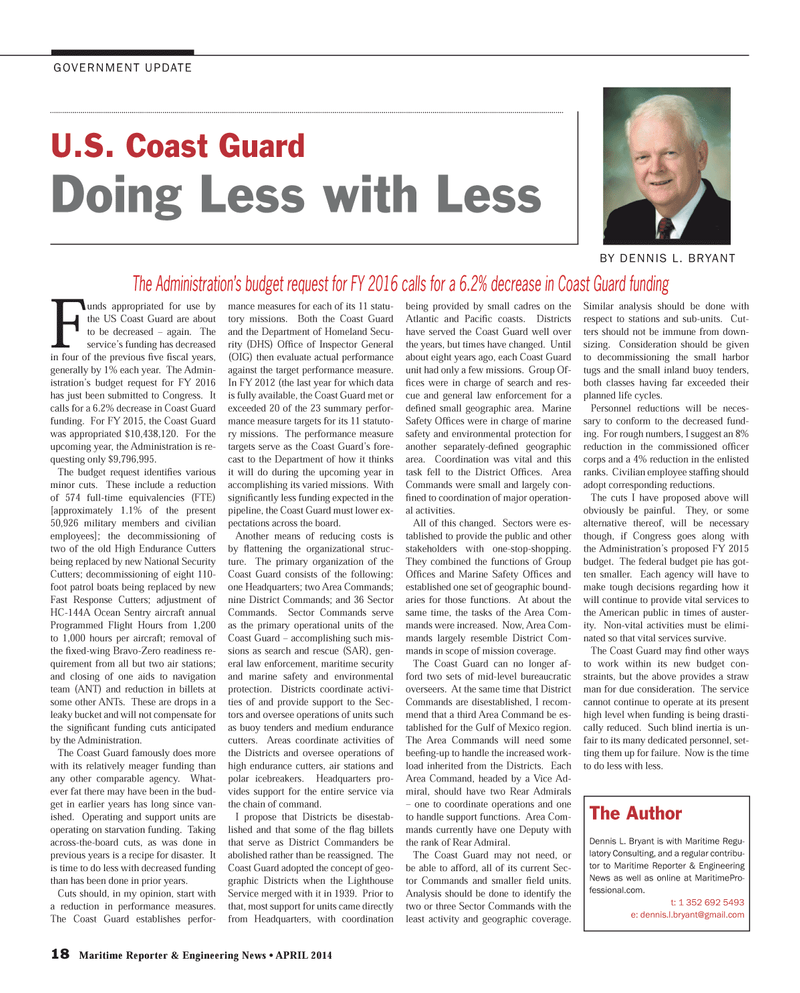
Page 18: of Maritime Reporter Magazine (April 2014)
Offshore Edition
Read this page in Pdf, Flash or Html5 edition of April 2014 Maritime Reporter Magazine
18 Maritime Reporter & Engineering News ? APRIL 2014 GOVERNMENT UPDATE Funds appropriated for use by the US Coast Guard are about to be decreased ? again. The service?s funding has decreased in four of the previous Þ ve Þ scal years, generally by 1% each year. The Admin- istration?s budget request for FY 2016 has just been submitted to Congress. It calls for a 6.2% decrease in Coast Guard funding. For FY 2015, the Coast Guard was appropriated $10,438,120. For the upcoming year, the Administration is re- questing only $9,796,995. The budget request identiÞ es various minor cuts. These include a reduction of 574 full-time equivalencies (FTE) [approximately 1.1% of the present 50,926 military members and civilian employees]; the decommissioning of two of the old High Endurance Cutters being replaced by new National Security Cutters; decommissioning of eight 110- foot patrol boats being replaced by new Fast Response Cutters; adjustment of HC-144A Ocean Sentry aircraft annual Programmed Flight Hours from 1,200 to 1,000 hours per aircraft; removal of the Þ xed-wing Bravo-Zero readiness re- quirement from all but two air stations; and closing of one aids to navigation team (ANT) and reduction in billets at some other ANTs. These are drops in a leaky bucket and will not compensate for the signiÞ cant funding cuts anticipated by the Administration. The Coast Guard famously does more with its relatively meager funding than any other comparable agency. What- ever fat there may have been in the bud-get in earlier years has long since van-ished. Operating and support units are operating on starvation funding. Taking across-the-board cuts, as was done in previous years is a recipe for disaster. It is time to do less with decreased funding than has been done in prior years.Cuts should, in my opinion, start with a reduction in performance measures. The Coast Guard establishes perfor- mance measures for each of its 11 statu- tory missions. Both the Coast Guard and the Department of Homeland Secu-rity (DHS) OfÞ ce of Inspector General (OIG) then evaluate actual performance against the target performance measure. In FY 2012 (the last year for which data is fully available, the Coast Guard met or exceeded 20 of the 23 summary perfor- mance measure targets for its 11 statuto- ry missions. The performance measure targets serve as the Coast Guard?s fore- cast to the Department of how it thinks it will do during the upcoming year in accomplishing its varied missions. With signiÞ cantly less funding expected in the pipeline, the Coast Guard must lower ex-pectations across the board. Another means of reducing costs is by ß attening the organizational struc- ture. The primary organization of the Coast Guard consists of the following: one Headquarters; two Area Commands; nine District Commands; and 36 Sector Commands. Sector Commands serve as the primary operational units of the Coast Guard ? accomplishing such mis-sions as search and rescue (SAR), gen-eral law enforcement, maritime security and marine safety and environmental protection. Districts coordinate activi-ties of and provide support to the Sec-tors and oversee operations of units such as buoy tenders and medium endurance cutters. Areas coordinate activities of the Districts and oversee operations of high endurance cutters, air stations and polar icebreakers. Headquarters pro-vides support for the entire service via the chain of command.I propose that Districts be disestab-lished and that some of the ß ag billets that serve as District Commanders be abolished rather than be reassigned. The Coast Guard adopted the concept of geo-graphic Districts when the Lighthouse Service merged with it in 1939. Prior to that, most support for units came directly from Headquarters, with coordination being provided by small cadres on the Atlantic and PaciÞ c coasts. Districts have served the Coast Guard well over the years, but times have changed. Until about eight years ago, each Coast Guard unit had only a few missions. Group Of-Þ ces were in charge of search and res- cue and general law enforcement for a deÞ ned small geographic area. Marine Safety OfÞ ces were in charge of marine safety and environmental protection for another separately-deÞ ned geographic area. Coordination was vital and this task fell to the District OfÞ ces. Area Commands were small and largely con- Þ ned to coordination of major operation- al activities.All of this changed. Sectors were es-tablished to provide the public and other stakeholders with one-stop-shopping. They combined the functions of Group OfÞ ces and Marine Safety Of Þ ces and established one set of geographic bound-aries for those functions. At about the same time, the tasks of the Area Com- mands were increased. Now, Area Com- mands largely resemble District Com- mands in scope of mission coverage. The Coast Guard can no longer af-ford two sets of mid-level bureaucratic overseers. At the same time that District Commands are disestablished, I recom-mend that a third Area Command be es- tablished for the Gulf of Mexico region. The Area Commands will need some beeÞ ng-up to handle the increased work- load inherited from the Districts. Each Area Command, headed by a Vice Ad- miral, should have two Rear Admirals ? one to coordinate operations and one to handle support functions. Area Com- mands currently have one Deputy with the rank of Rear Admiral. The Coast Guard may not need, or be able to afford, all of its current Sec- tor Commands and smaller Þ eld units. Analysis should be done to identify the two or three Sector Commands with the least activity and geographic coverage. Similar analysis should be done with respect to stations and sub-units. Cut-ters should not be immune from down-sizing. Consideration should be given to decommissioning the small harbor tugs and the small inland buoy tenders, both classes having far exceeded their planned life cycles. Personnel reductions will be neces-sary to conform to the decreased fund-ing. For rough numbers, I suggest an 8% reduction in the commissioned ofÞ cer corps and a 4% reduction in the enlisted ranks. Civilian employee stafÞ ng should adopt corresponding reductions.The cuts I have proposed above will obviously be painful. They, or some alternative thereof, will be necessary though, if Congress goes along with the Administration?s proposed FY 2015 budget. The federal budget pie has got- ten smaller. Each agency will have to make tough decisions regarding how it will continue to provide vital services to the American public in times of auster- ity. Non-vital activities must be elimi- nated so that vital services survive.The Coast Guard may Þ nd other ways to work within its new budget con-straints, but the above provides a straw man for due consideration. The service cannot continue to operate at its present high level when funding is being drasti-cally reduced. Such blind inertia is un-fair to its many dedicated personnel, set-ting them up for failure. Now is the time to do less with less.U.S. Coast Guard Doing Less with LessBY DENNIS L. BRYANT The AuthorDennis L. Bryant is with Maritime Regu- latory Consulting, and a regular contribu- tor to Maritime Reporter & Engineering News as well as online at MaritimePro- fessional.com. t: 1 352 692 5493 e: [email protected] The Administration?s budget request for FY 2016 calls for a 6.2% decrease in Coast Guard funding MR #4 (18-25).indd 18MR #4 (18-25).indd 184/5/2014 3:12:34 PM4/5/2014 3:12:34 PM

 17
17

 19
19
